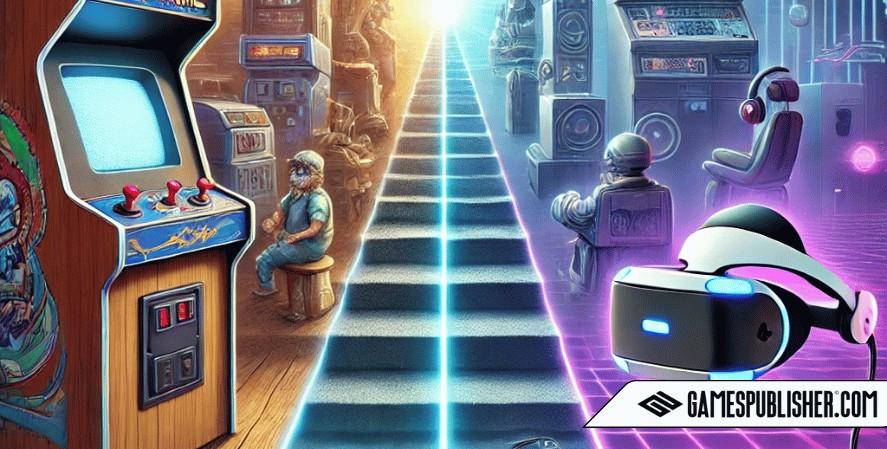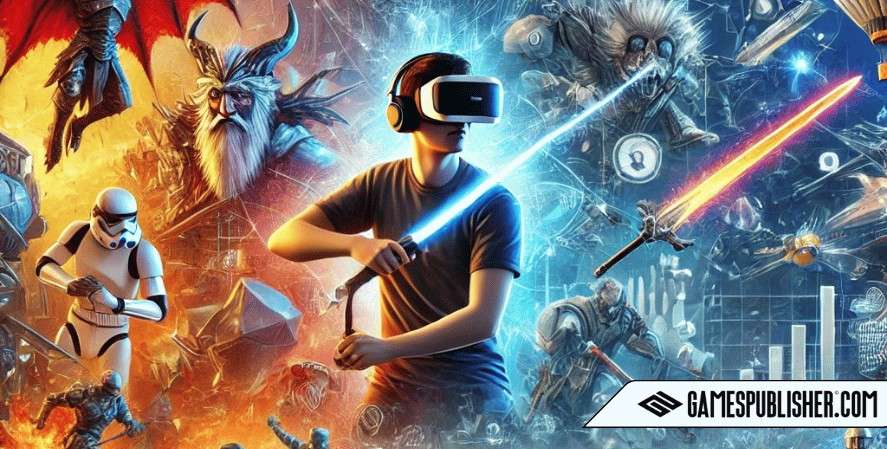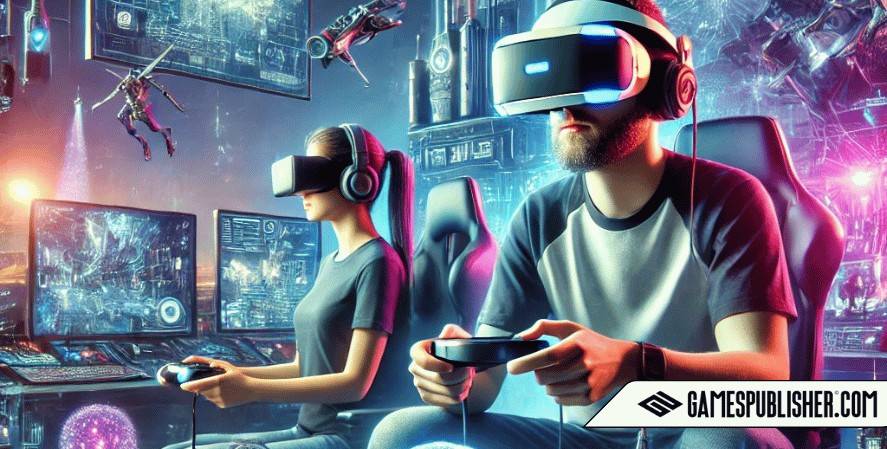Virtual reality (VR) has changed the gaming world. It lets players step inside virtual worlds and feel like they’re really there. But VR gaming wasn’t always this advanced. It took years of work from pioneers and inventors to make it what it is today. In this article, we’ll explore how VR gaming began, the people who made it possible, and how VR has evolved over time.
The Evolution of Game Genres: A Brief Overview

What Are Game Genres?
Before diving into VR games, it’s helpful to understand game genres. A game genre is a type of game based on its style and rules. For example, shooters are games where players shoot at targets, while puzzle games make players solve problems.
Game genres set expectations for players. When people pick up a game labeled as an RPG (role-playing game), they expect a story, characters to develop, and choices to make.
Genres also help game developers and publishers. When they know what players expect, they can design the right game mechanics and stories. This helps them reach the right audience and create games that players want to play.
Early Innovations in Gaming
In the early days of video games, developers created many of the genres we still play today. The 1980s and 1990s were a time of major creativity in gaming. Games like Super Mario Bros. introduced platformers, where players jump and explore. Doom created the shooter genre, and Final Fantasy brought complex storytelling to RPGs. These early games laid the foundation for modern gaming.
The Beginnings of Virtual Reality in Gaming
The Idea of VR in Pop Culture
Before VR existed, people dreamed about it. Movies and books imagined worlds where people could enter virtual spaces. This idea inspired real-life inventors to try and make VR a reality.
In the 1980s, a man named Jaron Lanier helped bring VR to life. Lanier started a company called VPL Research, which was one of the first companies to work on VR technology. His company created early VR gloves and headsets. Lanier even came up with the term “virtual reality.” His work made people believe that VR could be real and not just a fantasy.
Early VR Experiments in Gaming
The first attempts to use VR in games happened in the late 1980s and 1990s. These early devices were very basic compared to today’s VR.
For example, in 1993, Sega tried to create a VR headset called Sega VR, but it was never released to the public. In 1995, Nintendo launched the Virtual Boy, which displayed 3D visuals in red and black. However, it was uncomfortable to use and didn’t sell well.
These early VR attempts didn’t succeed, but they showed that game companies wanted to make VR a reality. Even though the technology wasn’t ready yet, these efforts set the stage for the future.
Modern Pioneers of VR Gaming

Oculus Rift Brings VR Back to Life
The modern era of VR gaming began with the Oculus Rift. In 2012, a young inventor named Palmer Luckey launched a Kickstarter campaign to fund his VR headset, the Oculus Rift. His goal was to make VR more affordable and high-quality. The campaign was very successful, raising almost $2.5 million.
In 2014, Facebook bought Oculus for $2 billion. This huge investment sparked new interest in VR. The Oculus Rift officially launched in 2016 and made VR gaming more popular than ever. Many game developers started creating VR games, helping to grow the VR market.
Valve and the HTC Vive
Soon after Oculus, Valve Corporation teamed up with HTC to create the HTC Vive. The Vive launched in 2016 and brought some new features to VR. Unlike the Oculus Rift, which was meant for seated experiences, the Vive allowed players to move around. This is called “room-scale VR.” The Vive also had motion controllers, so players could use their hands in VR, making the experience feel more real.
The HTC Vive raised the bar for VR gaming. With room-scale VR and motion controls, it allowed players to fully interact with virtual worlds. This technology pushed VR gaming to new heights and inspired even more developers to create VR games.
Sony PlayStation VR and VR for the Masses
Sony entered the VR market with PlayStation VR (PSVR) in 2016. Unlike Oculus and HTC, which needed powerful computers, the PSVR worked with the PlayStation 4 console. This made it more affordable and accessible to a larger audience.
PSVR helped bring VR to a mainstream audience, giving millions of players a chance to try VR gaming. Sony’s focus on quality and accessibility made PSVR a huge success. It proved that there was a big demand for VR gaming among everyday gamers, not just tech enthusiasts.
Defining VR Genres and Their Impact on Game Development

Adapting Existing Genres for VR
As VR gaming grew, developers began creating VR versions of traditional game genres. For example, first-person shooters, puzzle games, and RPGs (role-playing games) all found new life in VR.
Games like Arizona Sunshine brought zombie shooting to VR, and Moss let players explore a magical world in 3D. These games kept the basics of their genres but changed them to fit the VR experience.
In VR, players don’t just press buttons; they use their whole body to interact with the game. This makes games feel more real and immersive.
New VR-Only Genres
VR has also created new types of games that wouldn’t work outside of VR. For example, “VR simulators” like Job Simulator let players experience everyday tasks in a fun, exaggerated way.
Social VR platforms like VRChat and Rec Room let people meet and interact in virtual worlds. These experiences blend gaming with social interaction, creating a unique experience only possible in VR.
These VR-specific genres highlight the potential of VR to create new types of experiences that go beyond traditional gaming.
Impact on Game Development
The shift to VR has changed how developers think about game design. In VR, traditional menus and controls don’t work well, so developers must create new ways to interact with the game.
For example, many VR games use “point-and-click” or hand gestures instead of traditional buttons. Spatial audio, which lets sounds come from different directions, also plays a big role in VR.
For game developers and publishers, creating VR games is both exciting and challenging. VR offers a fresh way to engage players, but it also requires new skills and ideas to make games that feel natural and fun.
The Future of VR in the Gaming Industry

Advances in VR Technology
New VR technology is making headsets lighter, more comfortable, and wireless. Improved motion tracking and haptic feedback (vibrations and sensations) make VR more realistic. These advancements make VR easier to use and allow for more detailed, immersive games.
How AI Could Change VR
Artificial intelligence (AI) could make VR worlds even more interactive. Imagine NPCs (non-player characters) that remember what you did or respond to you in real-time. AI could create dynamic environments that react to the player, making VR worlds feel truly alive. As AI technology advances, it could lead to even more engaging VR experiences.
Market Trends and Growth in VR Gaming
The VR gaming market is growing quickly. As VR technology becomes more affordable, more people are buying VR systems. VR’s popularity is also boosted by the concept of the “metaverse,” where VR and augmented reality (AR) are blended to create large, interactive worlds. These trends suggest that VR gaming will continue to grow.
Conclusion
VR gaming has made significant progress since it first began. What started as a dream in science fiction is now a thriving part of the gaming world. VR has brought new ways to play, new genres, and new challenges for developers. As technology continues to advance, VR gaming will keep evolving, offering players even more immersive and interactive experiences.
For game developers and publishers, VR is a chance to create something fresh and exciting. VR gaming is still in its early days, and there’s so much more to explore. The immersive revolution has only just begun, and the future of VR in gaming looks brighter than ever.
Loading survey...

